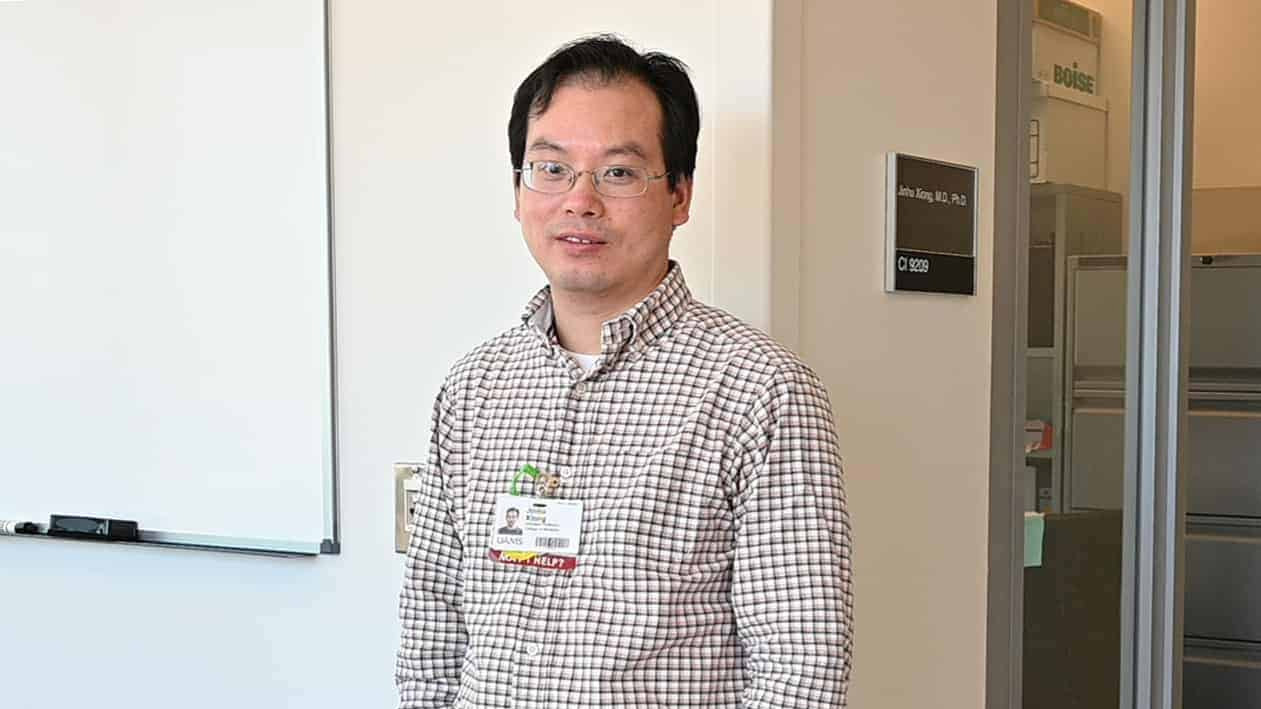UAMS Researcher Receives $1.7 Million Grant to Study Bone Health, Exercise Connection
| LITTLE ROCK — A researcher at the University of Arkansas for Medical Sciences (UAMS) has received a $1.7 million grant from the National Institutes of Health to study how physical activity improves bone health, with possible implications for bone loss from osteoporosis and aging.
Jinhu Xiong, Ph.D., is an assistant professor in the Department of Orthopaedic Surgery in the UAMS College of Medicine, and is one of several researchers from various disciplines at UAMS focusing on bone science as part of the Center for Musculoskeletal Disease Research. Xiong received the five-year grant from the National Institute of Arthritis & Musculoskeletal & Skin Diseases.
“Scientists have long understood there is a connection between bone size and strength related to physical activity,” Xiong said. “Reduced physical activity due to disability or long-term bed rest causes profound bone loss and increases the risk of fractures. As we age and become less active, we also tend to lose bone. Despite these correlations, what scientists don’t know is exactly how the skeleton senses and responds to changes in physical activity.”
About 54 million Americans have low bone mass. An estimated one in two women and one in four men over 50 break a bone because of osteoporosis.
Xiong began studying the underlying biological mechanisms behind bone health in 2008 as a Ph.D. student at UAMS.
One way researchers are working to understand bone loss is to focus on the interaction of bone cells called osteoblasts and osteoclasts. During the body’s normal cycles, osteoblasts build new bone and osteoclasts reabsorb old bone. When they are out of balance, osteoporosis or other conditions related to bone loss can develop.
Xiong’s dissertation centered around his groundbreaking finding that a particular type of cell buried within the bone matrix, called osteocytes, controls the formation of osteoclasts. Xiong’s research suggests these osteocytes are important for how the body senses and responds to physical activity.
This grant funding from the NIH will allow him to test his hypothesis about the connection between osteocytes and physical activity in a number of different ways.
“Ultimately, we’re seeking to understand the biologic underpinnings of this interplay between the osteocytes, physical activity and osteoblasts, so we can find a particular protein or pathway to target with a drug therapy,” Xiong said. “It’s a promising route for finding a potential treatment for osteoporosis and other types of bone loss.”
The Center for Musculoskeletal Disease Research is one of several such centers at UAMS that aim to concentrate multidisciplinary expertise in an area of research at an institution. It is funded through the National Institute of General Medical Sciences through a Center of Biomedical Research Excellence (COBRE) grant. Charles O’Brien, Ph.D., directs the center and is a professor with dual appointments in the Division of Endocrinology in the Department of Internal Medicine and the Department of Orthopaedic Surgery.
In addition to building synergistic collaboration around a certain research topic – in this case, bone health – the COBRE program aims to support promising researchers who are early in their careers and have not yet received a major funding grant to support their work. Participants are supported with funding, mentorship and training on best practices for gaining grant funding.
By earning this $1.7 million grant from the NIH, Xiong moves into his career as a self-supporting scientist, and a spot will open in the Center for Musculoskeletal Disease Research for another early career scientist interested in bone research.
“The COBRE program aims to bridge the gap between promising new scientists and their ability to sustain their work through consistent funding so we don’t lose potentially groundbreaking discoveries to the logistical difficulties of obtaining grant funding when scientists are just starting out,” O’Brien said. “UAMS has a long tradition of excellence in bone research, and as each participant in the COBRE establishes themselves in their career, we strengthen that legacy. Dr. Xiong has fit right in with the center’s goals, and I can’t wait to see where his research will lead next.”
In addition to osteoporosis, other research supported by the center focuses on multiple myeloma, cancer metastases to bone, osteoarthritis, osteomyelitis and abnormal skeletal development.
UAMS is home to other centers funded by the COBRE program focusing on research in cancer therapy, infection, childhood obesity and pediatrics.
UAMS is the state’s only health sciences university, with colleges of Medicine, Nursing, Pharmacy, Health Professions and Public Health; a graduate school; a hospital; a main campus in Little Rock; a Northwest Arkansas regional campus in Fayetteville; a statewide network of regional campuses; and eight institutes: the Winthrop P. Rockefeller Cancer Institute, Jackson T. Stephens Spine & Neurosciences Institute, Harvey & Bernice Jones Eye Institute, Psychiatric Research Institute, Donald W. Reynolds Institute on Aging, Translational Research Institute, Institute for Digital Health & Innovation and the Institute for Community Health Innovation. UAMS includes UAMS Health, a statewide health system that encompasses all of UAMS’ clinical enterprise. UAMS is the only adult Level 1 trauma center in the state. UAMS has 3,275 students, 890 medical residents and fellows, and five dental residents. It is the state’s largest public employer with more than 12,000 employees, including 1,200 physicians who provide care to patients at UAMS, its regional campuses, Arkansas Children’s, the VA Medical Center and Baptist Health. Visit www.uams.edu or uamshealth.com. Find us on Facebook, X (formerly Twitter), YouTube or Instagram.
###
